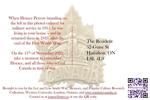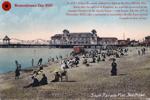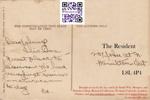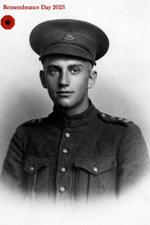When more than 400 people across the country get their mail this week, it will include a postcard from the front lines of the First World War.
The unique mail is the handiwork of Western University history professor Jonathan Vance and three of his students, and is focused on connecting Canadians with the First World War in conjunction with Remembrance Day.
Some are replicas of postcards and messages crafted by soldiers who served from 1914 to 1918, and sent to the same addresses as the originals. Others are photographs of soldiers printed on postcard stock and mailed to the address at which the soldiers lived when they enlisted.
Vance, a Waterdown native, said he hopes the project causes people to pause and reflect on Remembrance Day — and also helps to keep the soldiers’ stories alive. He noted for many Canadians, the First World War seems like “the ancient past.”
“I just wanted to remind them that it actually wasn’t that long ago — that the people who were involved in this war were in our communities not very long ago — they lived in our houses, they went to our schools, they went to our churches, they worked in our businesses,” he said. “By using a house and a family that lives here now and the family that lived there in 1914, it’s a good way to remind people that the history is really all around them, and it’s not in the distant past — it’s really part of the fabric of the community now.”
Replicas of postcards from soldiers on the front lines of the First World War are being sent to more than 400 addresses across the country — including 45 in Hamilton and area — in conjunction with Remembrance Day. Hamilton's Horace Perrow enlisted in 1915 and returned to the city in 1919 at the end of the First World War.

Replicas of postcards from soldiers on the front lines of the First World War are being sent to more than 400 addresses across the country — including 45 in Hamilton and area — in conjunction with Remembrance Day. Hamilton's Horace Perrow enlisted in 1915 and returned to the city in 1919 at the end of the First World War.
Vance, who teaches military history, Canadian history and social memory, and is currently researching the First World War, Canadian culture and prisoners of war, said he has been collecting postcards for 25 to 30 years. The compilation is now known as the Ley and Lois Smith War, Memory and Popular Culture Research Collection and encompasses some 15,000 postcards.
While he had the idea to mail out the replica postcards years ago, he didn’t have the research staff to pull it off. But over the summer, Vance had three research assistants — Rylee Brooks, Bailey Ashton and Alejandra Largo Alvarez — who worked on the project full time.
“It was a relatively labour-intensive process,” he said.
The team had to sift through the 15,000 postcards, searching for those that could be connected to specific soldiers, and those where the house at the original address still stood. Vance said many houses no longer exist due to urban renewal, meaning it took a long time to narrow down the search.
 Replicas of postcards from soldiers on the front lines of the First World War are being sent to more than 400 addresses across the country — including 45 in Hamilton and area — in conjunction with Remembrance Day. Hamilton's William Chaloner sent this postcard to his daughter in 1915.
Replicas of postcards from soldiers on the front lines of the First World War are being sent to more than 400 addresses across the country — including 45 in Hamilton and area — in conjunction with Remembrance Day. Hamilton's William Chaloner sent this postcard to his daughter in 1915.

Replicas of postcards from soldiers on the front lines of the First World War are being sent to more than 400 addresses across the country — including 45 in Hamilton and area — in conjunction with Remembrance Day. Hamilton's William Chaloner sent this postcard to his daughter in 1915.
They also researched the soldiers to be able to include some information about them on the postcards, he added. The postcards were then photoshopped to digitally remove the original stamp, resized to modern Canada Post standards, printed and mailed.
Brooks, a fourth-year history student, said she hopes the project will lead people to reflect on Remembrance Day, and on the people who lived in their homes.
“I hope it generates more interest in history,” she added.
She said she was struck by the type of information soldiers decided to send home, including a lot of talk about the weather.
Fellow fourth-year history student Ashton said she was also struck by the mundane topics in the postcards.
“But to the people receiving these postcards, it would have been a huge relief that their family member was safe,” she said.
The postcards started to get mailed during the first week of November, in order to arrive as close to Remembrance Day as possible, Vance said, noting the last batch will be sent Nov. 10.
“We wanted people to be thinking about Remembrance Day when they arrived.”

Replicas of postcards from soldiers on the front lines of the First World War are being sent to more than 400 addresses across the country — including 45 in Hamilton and area — in conjunction with Remembrance Day. Hamilton's Edgar Seymour sent this postcard to his brother in 1915.

Replicas of postcards from soldiers on the front lines of the First World War are being sent to more than 400 addresses across the country — including 45 in Hamilton and area — in conjunction with Remembrance Day. Hamilton's Edgar Seymour sent this postcard to his younger brother in the family home in 1915 (
Vance said the mailings were only sent out to larger centres, because small towns didn’t use house numbers for mail and letters often weren’t mailed to streets. As a result, no postcards will be received in Waterdown or other Flamborough communities — but roughly 45 were sent to Hamilton, Burlington and Dundas.
The postcards feature a QR code linking to the Wartime Canada site and include Vance’s email for those who receive postcards to send feedback and get more information. He has already received some feedback, although none from Hamilton. While people are generally surprised at first, he said the majority think it is “really cool.”
Vance said Remembrance Day — and any annual observance — has the challenge of getting people engaged year after year, and he is always looking for something that will make people sit up and take notice.
“This certainly seems to have fit the bill,” he said.

Replicas of postcards from soldiers on the front lines of the First World War are being sent to more than 400 addresses across the country — including 45 in Hamilton and area — in conjunction with Remembrance Day. Hamilton's Allen Morgan enlisted for military service in 1916 and returned to the city in 1919 after the end of the First World War.


 Western University history professor Jonathan Vance (right) and fourth-year history student Bailey Ashton work on some of the 400 postcards from the front lines of the First World War sent to addresses across the country.
Western University history professor Jonathan Vance (right) and fourth-year history student Bailey Ashton work on some of the 400 postcards from the front lines of the First World War sent to addresses across the country.
 Replicas of postcards from soldiers on the front lines of the First World War are being sent to more than 400 addresses across the country — including 45 in Hamilton and area — in conjunction with Remembrance Day. Hamilton's William Chaloner sent this postcard to his daughter in 1915.
Replicas of postcards from soldiers on the front lines of the First World War are being sent to more than 400 addresses across the country — including 45 in Hamilton and area — in conjunction with Remembrance Day. Hamilton's William Chaloner sent this postcard to his daughter in 1915.



